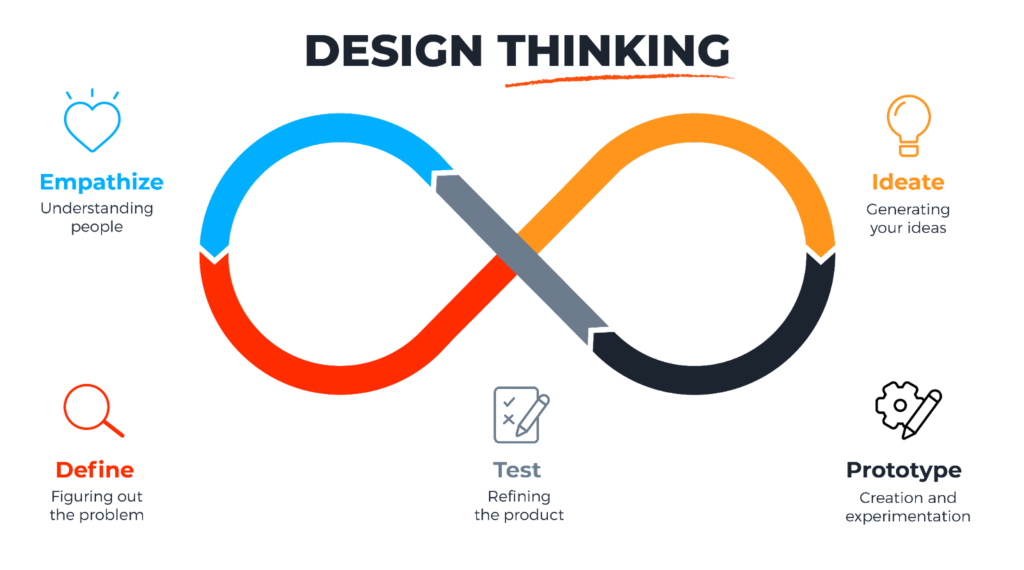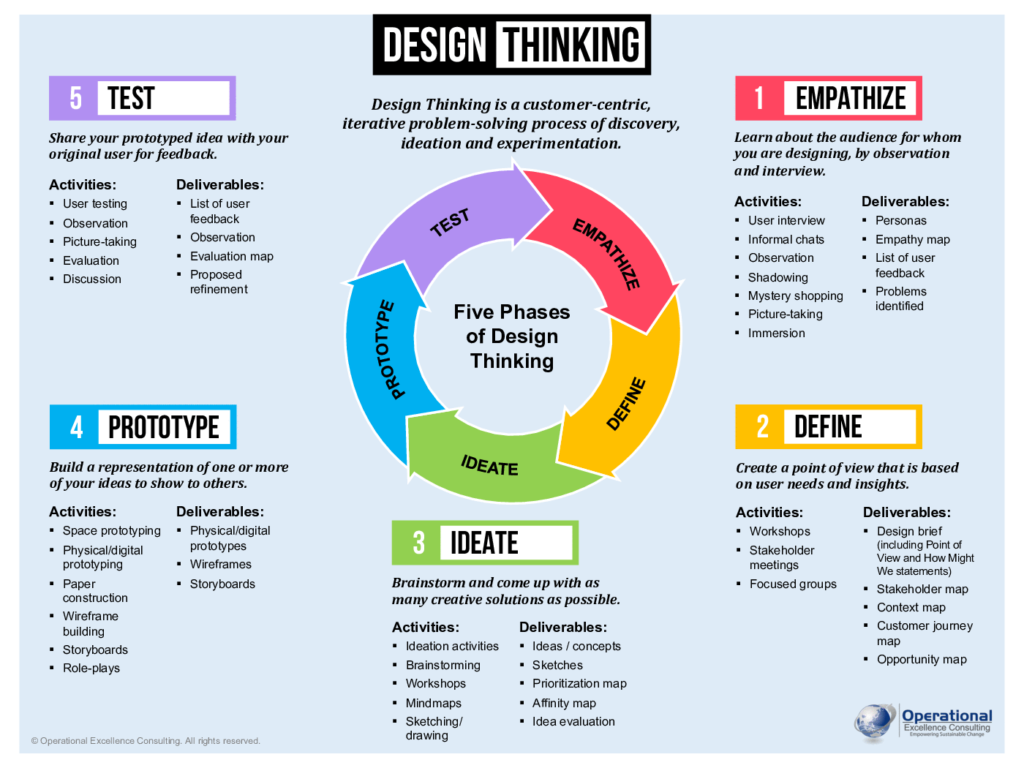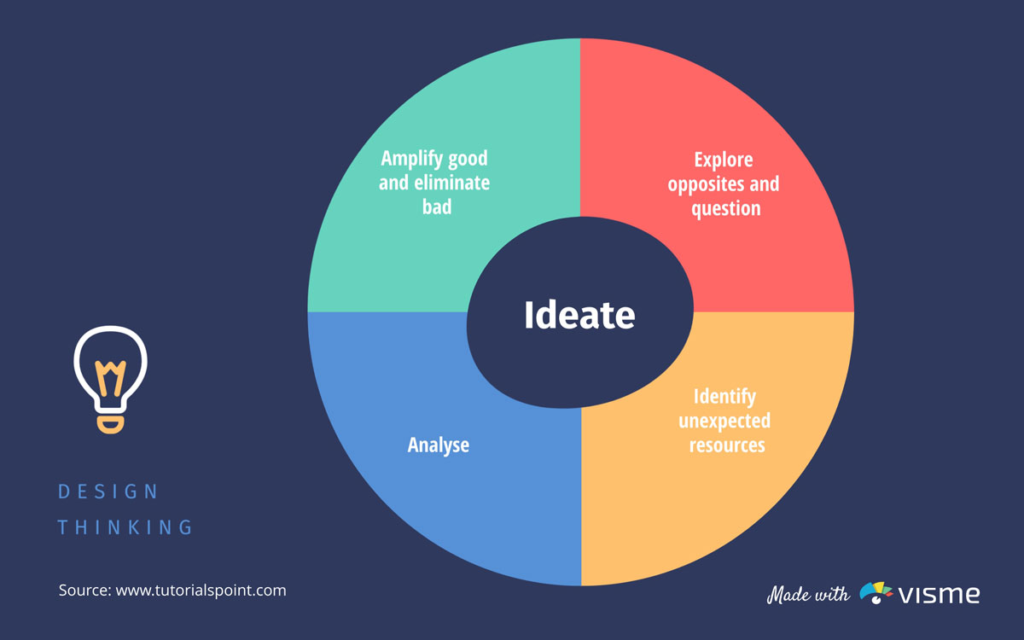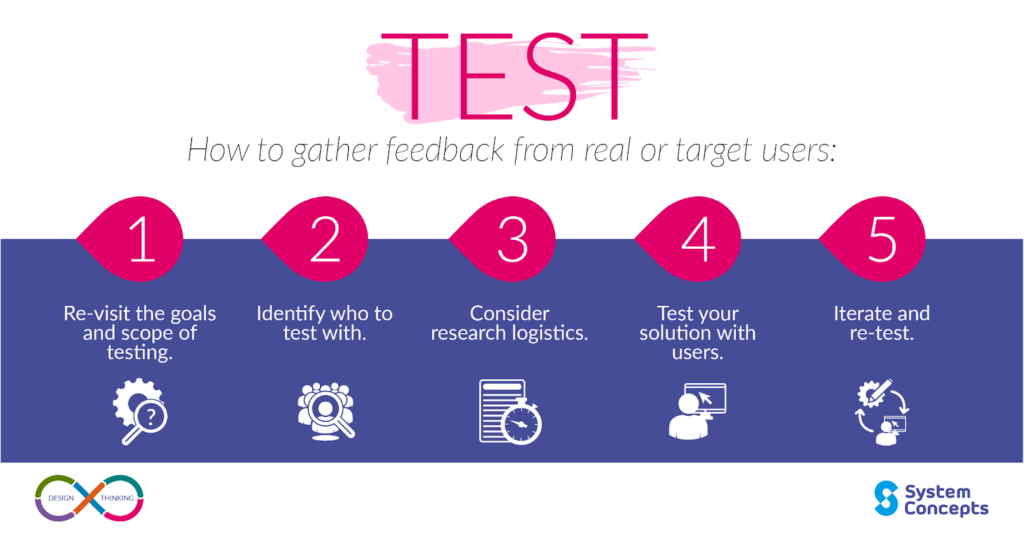What Is Design Thinking, And How Does it Impact Your Business?

Table of Contents
- What Is Design Thinking?
- How Does Design Thinking Impact Your Business?
- What are the Five Stages of the Design Thinking Process?
- How Did Design Thinking Evolve with Time?
- Conclusion
- Key Takeaways
- FAQs
Wondering what approach would be better to overcome creative problem-solving issues? If you are having a tough time finding a solution to such a question, it is time you explore and understand the design thinking concept. This problem-solving approach will allow your creative ideas to flow while helping you adhere to the deadlines.
Before we dive right into how it helps you with a strategic designing approach, let’s first get an answer to what is designing below.

What Is Design Thinking?

Design thinking is a problem-solving approach that is used by teams to identify people they need to target, break down challenges and work issues, and build a solution that is essential for the end users. The final product goes through thorough testing and one may end up building several prototypes to see which one matches the end user’s needs.
You are working towards resolving all the challenges one might face during the development or implementation phases. This term is quite the buzzword among the design community and product inventors dedicated to understanding customer perspectives and solving their issues.
According to Tim Brown, the design thinking concept applies to all spheres of life. It is integral to every industry and not limited to a specific area of expertise. You can implement a solid design thinking methodology to end problems that persist in different industries and transform the typical operations like HR, finance, marketing and others.
How Does Design Thinking Impact Your Business?

By now, you have formed a more-or-less lucid notion about design thinking, why and how it came into being, etc.
But you must also understand that the design thinking concept transcends into a robust design thinking methodology that is already impacting businesses. Companies that put design thinking at the very core of their brand and implement design thinking everywhere – from research, strategy, content creation, and other operations that solve problems and spur innovation, have encountered positive impact over the years.
Let’s see how high design thinking methodology has had an immensely positive impact on businesses.
1. Design thinking increases competitive performance
Like discussed above, design thinking-led companies regularly outperform the S&P Index. As of 2019, design thinking has enabled businesses to outperform their peers by 228%.
2. Design thinking encourages companies to prioritize customer relationships
Prioritizing customer interactions and customer demands has been a defining characteristic of firms which are motivated by design thinking. 46% of such design leaders consciously emphasize upon customer sentiments and form emotional bonds with their customers. In this way, solving customer problems through innovation remains their top priority.
3. Design thinking ensures cost-savings, seamless marketing and project management
Design thinking has helped companies get their products to market faster at more competitive rates. According to Forrester, such companies cut their design and alignment costs by nearly 75% – resulting in US$ 872,000 of cost savings and roughly US$ 1.1 million savings for large projects!
4. Design thinking has helped brands become better
Design thinking is at the core of all the decisions made at the most successful brands of all time. AirBnB bounced back from a failing startup into one of the world’s most successful brands by implementing design thinking.
Similarly, other brands like Nike, IBM, Google, etc., have encountered wild success with the design thinking concept altering their course of history. A famous interview given to Harvard Business Review by Indra Nooyi – former PepsiCo CEO, whose 12-year tenure saw around 80% brand growth, had a famous section where she admitted that design had a voice in almost every crucial decision taken by the company.
5. Design thinking improves internal creation competency and productivity of organizations
Since the inception of design thinking and its implementation in business practices, more than 82% of the companies believe that there is a strong connection between creativity and robust business results.
Amongst these companies, almost 71% of the organizations have claimed that design thinking has improved their internal work culture at team levels, while simultaneously attributing design thinking to 10X their assets to what they had only a few years back!
6. Design thinking leads to improved customer experience (CX)
Companies that have incorporated design thinking at the core of their operations have undergone some of the most phenomenal results in terms of CX (customer experience). While 78% of those companies prioritizing design have come up with novel, digital CX initiatives, 83% have dedicated tools and systems in place to test unique CX ideas.
And the results? More than 50% of design-led companies have reported increased customer retention and customer loyalty to their brands due to their best practices in design thinking. As of 2017, more than 10% of the Fortune 500 companies have stated that design thinking is their number one priority!
Although the facts and statistics above clearly demonstrate the perks and impacts of design thinking on businesses, it should also be noted that nearly 46% of companies that did not embed design thinking in their digital CX strategy reported a weaker customer experience compared to their industry compatriots.
The impact of design thinking in forging strong businesses and brands has been clearly established by some of the greatest thinkers and problem-solvers of our time.
What are the Five Stages of the Design Thinking Process?

After spending considerable time understanding the paramount importance of design thinking concept, let’s discuss the minutiae of design thinking methodology.
If you ask the scholars of the Hasso Plattner Institute of Design at Stanford, famously known as the d.school, they would break down the design thinking methodology in five steps. However, one thing to note about these steps is that they are not always sequentially implemented. Often, these steps occur parallely, or in a shuffled pattern, and are repeated iteratively.
Stage 1 – Empathize
This stage is all about researching the needs and perspectives of the customers regarding a particular problem. When companies employ user research to comprehend the problem they are trying to solve, it takes an empathetic understanding of the same to gain access to previously uncharted and unthought-of territories.
The design thinking meaning has a human-centered approach. Therefore, empathy will help the organizations abolish their preset notions and assumptions and gain real insights into the problems. Empathy takes an organization a long way to deal with the situation and come up with solutions that satisfy the users.
Stage 2 – Define
Once the business has researched the users’ needs by employing empathy and putting themselves in the user’s shoes, it is time to gather information. Analyze the accumulated information with the help of data analytics and relevant tools to convert the observations into problem statements.
Problem statements are synthesized from identified observations and can also be tested on artificial buyer personas before implementing the subsequent phases.
Stage 3 – Ideate

Once the core user problems and needs have been identified and stated, it is time to generate ideas. The first two phases offer you deep insights, observations, and a knowledge repository. You have to put these to good use, alter the conventional problem-solving approaches, and modify the traditional schemas.
Think outside the box, look at the problem from multiple user perspectives, and create innovative solutions to these problems through individual and group brainstorming sessions.
Stage 4 – Prototype
Creating a prototype is when you are ready to utilize your resources and experiment to identify the best possible customer solutions. A prototype is not the finished product that is ready for launch. Instead, it consists of a scaled-down, inexpensive product or one that consists of the specific problem-solving attributes of the product to test the ideas generated in the previous phases.
Stage 5 – Test

Unarguably the final stage of the entire design thinking methodology, here you employ regulators and quality control professionals to test the prototypes under stringent environments and multiple use-cases.
As indicated above, design thinking is often iterative and does not follow strict sequences during application. When you test the results, you identify further problems that redefine the product and return to prototyping or earlier phases to reshape the product or the service. Further iterations, alterations, and refinements result in the formation of the Minimum Viable Product (MVP) – ready for launch in the open market while minimizing the investors’ risks and providing solutions to existing problems.
However, the five stages of the design thinking concept prove that they have a mutually synergistic effect on product development and problem-solving, rather than being discreet, sequential stages with individual goals. The ulterior motive of design thinking is to understand the user’s pain points and eliminate them.
How Did Design Thinking Evolve with Time?

The design thinking concept originally came into being when John E. Arnold, professor of mechanical engineering at Stanford University, wrote the book – Creative Engineering in 1959. He tried to establish ways for engineers to approach problems creatively like designers, rather than conventionally or within the rigidly-established patterns.
His text established the four areas of design thinking. This was a pivotal point where the design thinking concept became a “way of thinking” within science and design engineering.
Following this, the 80s saw the gradual emergence of human-centered design. The formation of the design consultancy IDEO in the 90s made design thinking a more mainstream approach.
With the dawn of the 21st century, businesses realized the relevance and sustainability of design thinking in their operations. The brands employing design thinking would get their products to market faster and enjoy more incredible fruits of success.
The design thinking meaning has been making transitions from the pages of a book to the production units of organizations. Stanford University’s d.school in 2005 introduced a design thinking course to fast-forward technical and social innovation.
Design thinking is still evolving with time. Till now, design thinking has evolved into a non-linear, iterative process that does the following.
- Helps to understand user problems
- Challenges existing assumptions and schemas
- Creates innovative solutions
Although being a strategic process, organizations often fail to value the creation competency of design thinking.
Conclusion
Design thinking is an amalgamation of human-centered innovation with technologically and economically viable products or solutions. Design thinking helps us solve existing or newly-unfolded problems using our creativity, intellect and out-of-the-box ideas, without depending on the traditional methods of finding such solutions.
Although design thinking has gained momentum in the business world through some of these noteworthy mentions, it has actually been in existence since the 1960’s. Being an amalgamation of approaches, the design thinking concept has become unique since it rapidly became an umbrella term to facilitate multi-disciplinary and human-centered projects in the creative and social fields to accelerate research and rapid ideation for problem solving.
Key Takeaways
- Design thinking is a problem-solving approach that helps businesses break down the challenges and come up with the best possible solutions.
- There are five steps of design thinking – empathizing with the customer, observing and defining their problems, ideating on the basis of observations and analysis, creating a prototype, and testing the prototype in the real world scenario to analyze its efficiency.
- Design thinking was created to find creative inroads into problem-solving situations that were highly different from the approaches taken by scientists and engineers. However, it slowly started focusing more on the efficacy of human-centered design and providing creative solutions to real-world problems.
- Businesses, large and small, are impacted highly by design thinking. That’s because design thinking when integrated with sustainability, socially, and ecologically ethical factors also helps you mold your work approach.
- When it comes to large organizations, creating a culture of design thinking within the workforce and actively nurturing it helps them to cut costs. They can also find ways to solve problems faster, collaborate easily, while attracting and retaining customers for a long time.
FAQs
What is design thinking is a very common question thrown to designers and non-designers alike. It is a consumer or customer-centric approach polished and innovated by companies and relies on problem-solving to prioritize customer needs and guarantee customer satisfaction.
The design thinking methodology depends upon acute observation of how the customer interacts with its environment upon encountering the problem. It finally employs an iterative, hands-on approach to develop innovative solutions that eliminate such problems.
According to IDEO founder David Kelley, the principles of design thinking concept revolve around a human-centered approach towards innovation. For this, the designers and their tools are needed in step one.
It considers the needs of the people, integrates those needs in the design methodology, imbibes the technological developments that can cause a breakthrough, and also the elements required for business success. Finally, design thinking helps you arrive at the desired solution.
Design thinking is actually a problem-solving approach. Its end use is to develop innovative solutions that take the user’s perspective of dealing with the problem into consideration and combine it with rational and analytical research to reach the desired target.
The design thinking concept first found its mention in the 1969’s book, Sciences of the Artificial, written by computer scientist and Nobel Laureate Herbert A. Simon. Since then, several pioneers of science and design have addressed design thinking as the science or way of thinking to solve customer-centric problems.
Since design thinking circumnavigates innovation, it is often hard to decipher the origin of the phrase. Although many people attribute the coinage of the word design thinking to Tim Brown, because it exploded in popularity and became a buzzword after that usage.
However, it is called design thinking because of a very practical, yet unconventional reason. Big corporations often fail to observe the unmet needs of their customers, and hence, their products fail to make an impact on the consumers. Design thinking urges organizations to be creative, and enhance their innovations, thereby influencing their consumers.
Latest Blogs
Explore how Google’s 2025 AI search updates triggered ranking chaos. Learn actionable strategies to adapt your SEO for AI Overviews, zero-click searches, and SERP volatility. Stay ahead now.
Learn how to rank on AI search engines like ChatGPT, Perplexity, and Gemini by optimizing your content for authority, structure, and relevance. Stay ahead in AI-driven search with this strategic guide.
Explore the best healthcare SEO services for your medical practice. Improve online visibility and effectively reach more patients in need of your services.
Get your hands on the latest news!
Similar Posts

Design
7 mins read
15 Best Firms Offering Design Services in India

Design
5 mins read
All You Need to Know About Data-Driven Design

Design
6 mins read